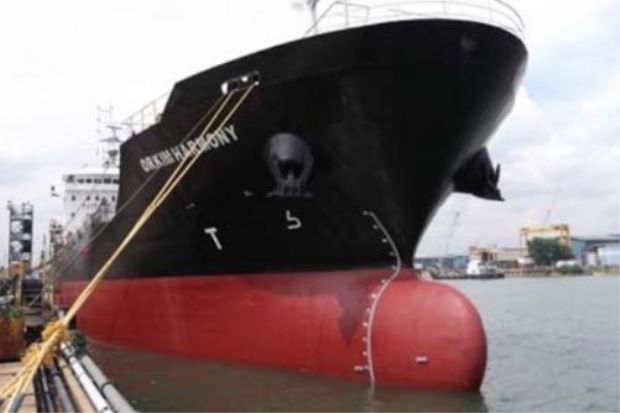MUNICH – Leaders of the Group of Seven industrialized nations were to start a two-day meeting Sunday in Germany at which Prime Minister Shinzo Abe will seek to drum up the major democracies’ opposition to attempts by Russia and China to “change the status quo” in Ukraine and the East and South China seas, respectively, by force.
Drawing parallels between the Ukraine crisis, sparked by Russia’s annexation of Crimea last year, and China’s massive land reclamation efforts in disputed waters in the South China Sea, Abe, together with his G-7 peers, is expected to urge Moscow and Beijing to refrain from muscle-flexing that is escalating tensions with other countries and to behave in accordance with international law, according to Japanese officials.
Japan is not among the claimant states in the South China Sea issue, but it is embroiled in a row with China over the Senkaku Islands in the East China Sea. China has repeatedly been sending state ships into Japanese waters around the Senkakus in an attempt to undermine Japanese administration of the islets, which are claimed as Diaoyu by China and Tiaoyutai by Taiwan.
“The situation in Ukraine is shaking the foundation of the basic rules of the international community,” a senior Foreign Ministry official said. “This is a problem not only for Europe, but the whole world, including Asia.”
Abe is attending the summit at Schloss Elmau, south of Munich, just days after affirming closer defense and security cooperation with the Philippines and Malaysia, two of the countries locked in territorial disputes with China in the South China Sea.
“As Japan is the only G-7 member from Asia, I would like to have substantial discussions on Asian affairs,” he told reporters Friday in Tokyo.
A senior U.S. official said the leaders of Britain, Canada, France, Germany, Italy, Japan and the United States will affirm the importance of maintaining sanctions on Russia to incentivize full implementation of a February cease-fire agreement, and to serve as a deterrent against further Russian aggression.
“It’s very important coming out of these G-7 meetings that the world is seen as speaking with one voice in support of those important consequences that have been imposed on Russia, and to demonstrate that Russia will continue to face those sanctions until a diplomatic solution is fully implemented,” Ben Rhodes, U.S. deputy national security adviser for strategic communications, said in a conference call Thursday.
The leaders also plan to focus on anti-terrorism measures, nuclear programs in Iran and North Korea, a China-led regional investment bank to be launched by the end of the year, as well as a new carbon-capping framework the United Nations aims to adopt at a climate change conference later this year in Paris, according to Japanese officials.
Abe is expected to explain Japan’s decision to reduce greenhouse gas emissions by 26 percent by 2030 from 2013 levels, and to express the nation’s willingness to contribute to the adoption of an emissions cut deal that will involve all countries, they said.
Separately, German Chancellor Angela Merkel is advocating a G-7 agreement for a 60 percent cut in greenhouse gas emissions globally by 2050 from 2010 levels in an effort to inject fresh momentum into climate negotiations in the run-up to the Paris meeting, according to G-7 delegates.
Abe is likely to call for transparency in the management and lending standards of the Asian Infrastructure Investment Bank, a position that is likely to be shared by other leaders, the Japanese officials said.
The G-7 members are split in their response to Beijing’s initiative.
While Britain, France, Germany and Italy have signed up to become founding members of AIIB, Canada, Japan and the United States have stayed out, given concern over the body’s governance and debt sustainability.
Abe also plans to explain about Japan’s recent announcement of a $110 billion, five-year “high quality” infrastructure investment initiative for Asia, a project some see as a bid to counter the AIIB, which will be initially capitalized at $100 billion.
Referring to his meeting Saturday with Ukraine President Petro Poroshenko in Kiev, Abe is likely to tell his G-7 peers that Japan, as G-7 president next year, will increase its engagement with Ukraine to help achieve a peaceful and diplomatic solution to the crisis.
As the situation remains unstable in eastern Ukraine with gunfire and battles continuing in some areas, the G-7 leaders will demand that all parties fully implement their commitment under a cease-fire agreement reached between Ukrainian government forces and pro-Russian separatists in February in Minsk.
On Monday, the leaders will hold enlarged talks with so-called outreach countries such as Ethiopia, Iraq, Liberia, Nigeria and Tunisia about terrorism, development, public health and women’s economic empowerment and entrepreneurship.
In the fight against terrorism, the leaders are likely to affirm efforts to degrade Islamic State militants through air campaigns inside Iraq, as well as to train and reinforce Iraqi security forces as they seek to reclaim territory taken by the militants.
Russia was invited to join the G-7 in 1998 and remained a member of what was then called the Group of Eight nations until last year when the G-7 suspended Moscow’s participation in retaliation for its actions in Ukraine.





